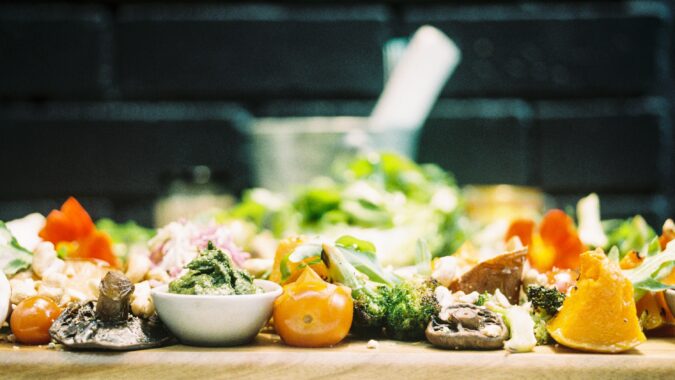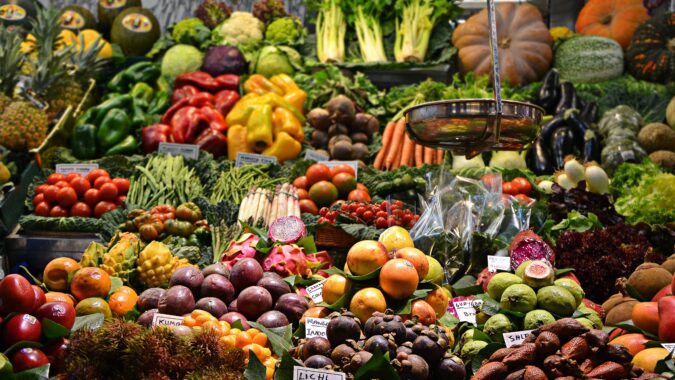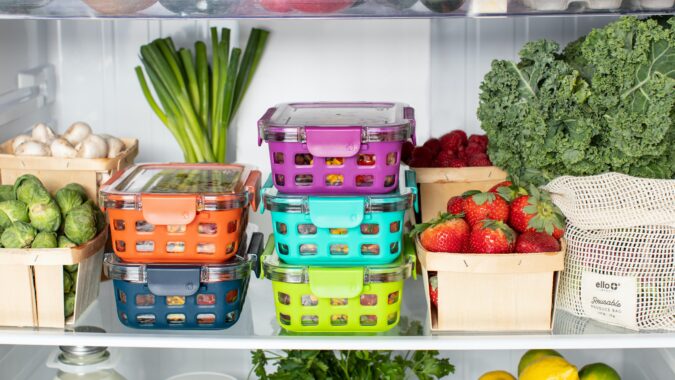Food Waste 2024 – the facts
From time to time, we’re all guilty of leaving some leftovers on our plates- whether you are eating out at a restaurant and aren’t enjoying your meal or try to avoid eating your vegetables as much as possible. While this issue may seem pretty minor, food waste is actually a global environmental issue that must be resolved sooner rather than later – here’s why.
Food waste facts
While there are many provisions in place to reduce food waste, the UK produces the highest amount of food waste in Europe.
- Over ⅓ of all food produced globally goes to waste.
- The UK throws away around 9.5 million tonnes of food waste in a single year – even though 8.4 million people in the UK are in food poverty.
- Billions of pounds are wasted each year when food is disposed of unnecessarily.

What is food waste?
To put it simply, food waste refers to any food products that are thrown away as opposed to being consumed. Typically, this waste can be split into four categories:
- By-product food waste. This refers to solid and liquid food by-products created through the manufacturing or production process or agricultural practices. This could include peels and trimmings from fruits & veg.
- Expired products. This refers to products that have surpassed their sell-by date in shops and supermarkets and cannot be consumed.
- Leftovers. This could refer to leftovers created in your household or leftovers acquired within restaurants and food preparation.
- Bakery and packaged food waste. This could refer to unsold food items that could spoil quickly or packaging waste.
What are some examples of food waste?
Just about any item of food can be classified as ‘food waste’. However, according to a recent study by River Cottage, the most commonly wasted items are:
- Bread
- Milk
- Potatoes
- Cheese
- Apples
What are the main causes of food waste?
There are many different causes of food waste. However, the leading causes are:
- Shops, supermarkets, or restaurants ordering too many products that will not sell.
- Poor education regarding how we should dispose of food waste.
- Lack of awareness of expiry dates, meaning that food is left to spoil instead of being used.
UK food waste statistics
Why is food waste a problem?
Food waste presents a significant problem due to the volume of waste that is produced each year. In fact, in the UK alone, it’s estimated that we throw away around 9.5 million tonnes of food waste annually. The vast majority of food waste ends up in a landfill site – which are already overcrowded. While many people do not view this as an issue as food items degrade naturally over time, it contributes heavily to global warming and the erosion of the OZ layer.
This is because food waste releases a great deal of methane gas as it breaks down. According to a report by the EPA, methane is 25 times more harmful than carbon dioxide because it can trap heat within the atmosphere.
Furthermore, food wastage is problematic from both a moral and economic standpoint. To put it simply, we throw away millions of pounds worth of food each year – even though many people across the globe go without fresh produce and groceries.

How can we reduce food waste?
Thankfully, there are various ways in which we can go about reducing food waste. Here are some great examples.
Food waste in the workplace
Whether you work within an office or factory, you will likely produce some form of food waste on-site. For example, this could include food that your employees bring for lunch or to snack on throughout the day. To reduce food waste in the workplace, you could:
- Have a communal shelf – where employees can share food/drinks they no longer want.
- Provide your employees with access to a freezer alongside a fridge to give any leftovers a longer shelf life.
- Ensure fridges are cleaned out regularly, and employees dispose of any food that will pass its use-by date.
- Offer to pay for lunches for your employees – giving them notice so they do not bring their lunch with them.
Food waste in restaurants
Restaurants, alongside bars, and pubs, are clear contributors to food waste. They can reduce the volume of waste they produce by:
- Keeping track of their stock cupboards, ensuring they do not purchase excessive amounts of products.
- Pay attention to consumer habits and buying stock accordingly. For example, some dishes may be more popular during a particular season.
- Avoiding over buying stock.
- Storing food safely and correctly.
- Labelling all food clearly, with instructions on when it will need to be used.
- Donating leftover food to local charities or organisations.
Food waste at home
Food waste also occurs every day within our homes. However, it can easily be reduced by:
- Pre-planning your meals so that you know exactly what to buy from the supermarket and do not waste money on groceries that will not get eaten.
- Cooking larger meals in bulk and freezing any leftovers to be enjoyed at a later date.
- Setting up a compost heap in your garden.
- Cleaning out your fridge regularly, ensuring that you are aware of all use-by dates.
Food waste at supermarkets
According to a report by The Grocer, supermarkets throw away 100,000 of edible food annually in the UK alone. In fact, it’s estimated that the UK’s total food waste could feed upwards of 30 million people a year. As a result, supermarkets have a responsibility to reduce food waste as much as possible. This can be achieved by:
-
- Training employees to be more aware of food waste and how it can be combated.
- Carefully monitoring stock to ensure that everything that is purchased is sold.
- Selling ‘damaged’ produce or produce that may not be aesthetically pleasing instead of throwing it away.
- Reducing products that may be close to their sell-by date.
- Donate surplus waste to charities or organisations.
Food waste on farms
While food waste is a product of just about any industry, it often occurs at places where the food is grown or produced – such as on farms. Thankfully, there are various steps farmers can take to reduce food waste. Such as:
- Investing in new technologies that make it easier to monitor and track crops’ growth minimises the chances of them being spoiled.
- Distributing goods to numerous facilities, whether that means local market stalls or chain supermarkets.
- Scheduling the growth of different crops to ensure as few crops are wasted as possible.
- Composting on-site.
Food waste in schools
As children can be notorious for throwing away the fruit you’ve packed into their lunchbox – it’s no surprise that food waste is a growing problem within schools. Food waste can be tackled in a school environment by:
-
- Introducing an ordering system – where students decide what they would like to eat for lunch earlier in the day and the dishes are made accordingly.
- Handling stock carefully and ensuring products are used before they expire.
- Monitoring portion control carefully, ensuring that excessive amounts of food are not being served.
- Informing students and staff of the dangers of food waste.
Food waste in the fishing industry
The fishing industry is another key contributor to food waste – for numerous reasons. For example, sometimes seafood is not considered fit for sale if it is damaged due to poor fishing practices. Fishing industry food waste can be reduced by:
- Refusing to discard fish at sea and finding alternative methods to dispose of surplus waste.
- Ensuring all fishermen are well-versed in efficient fishing and processing methods.
- Ensuring that all goods are labelled appropriately and stored by rigid health and safety guidelines.
- Paying attention to consumer trends and ensuring that products can be sold and distributed easily.

Which countries produce the most food waste?
The severity of food waste issues varies from country to country, but the biggest culprits for food waste in relation to their general populations are:
- The USA
- Canada
- Belgium
- Australia
- Austria
- Denmark
- Lithuania
- France
How much food waste comes from the home/from businesses?
It’s estimated that around 60% of food waste comes from the home within the UK – with the other 40% being divided out between business and the hospitality industry. Nevertheless, it is the business owner’s responsibility to ensure that all food waste produced or created within their company is safely and securely disposed of.
What do the date labels on food packaging mean?
Sometimes, food waste accumulates because we aren’t sure what the labels on our packaging mean. This means that we could be throwing away waste unnecessarily.
- Sell-by date. The sell-by date is only relevant to the retailer selling the product – and it refers to the time when the product must be sold to the customer. However, this doesn’t mean the food is close to expiring, as it typically has around ⅓ of its shelf life remaining when it reaches its sell-by date. As a result, you shouldn’t be wary of picking up these products.
- Use-by date. The use-by date is designed to help the consumer know when the food items should be consumed by. However, it’s important to remember that you can still consume food on its use-by date (but not afterwards). If you have any food approaching its use-by date and you don’t think you’ll use it in time, pop it in your freezer. The packaging will usually detail how long the items can be frozen for.
How should you store food
to minimise food waste?
Knowing how to store food properly will reduce the amount of food waste you produce significantly. Here are some tips to get you started:
- Store raw meats on one of the lower shelves on your fridge to stop cross-contamination of products if there are any leaks.
- Keep goods that expire quickly at the front of your fridge so that you don’t forget about them.
- Clean out your fridge once a week and your freezer once a month.
- If you are meal-prepping or batch cooking, label each dish so that you can remember exactly when you cooked it.
- Ensure that you know how each food item should be stored – be that within the fridge or at room temperature. If you are unsure, check the packaging.

Why should you portion plan?
Portion planning is a great way to keep track of the food you are eating, meaning that it is often used by those trying to adapt to a healthier lifestyle. However, it’s also a great way to reduce food waste – as it gives you the insight you need to shop smarter. For example, instead of buying random ingredients, you might not need or a handful of potatoes when you only need one – you’ll know exactly what you need to purchase ahead of time. This saves you money and stops food from going to waste!
What are some great food waste organisations
and what do they do?
A few great food waste organisations in the UK are:
- The Real Junk Food Project is a UK-based charity that redistributes surplus food from various hospitality and retail industries. They donate their goods to schools, organisations and charities and even offer bespoke catering services.
- Too Good To Go works with various restaurants and bars to ensure that none of their delicious food goes to waste. Users can download an app that lets them know what restaurants in their area offer a ‘magic bag’ of food – which often includes customer favourite items for a highly reduced price.
- Fare share aims to combat this issue of food waste by redistributing goods to over 10,500 different charities in the UK.
- The Felix Project collects fresh produce from supermarkets and hospitality venues that cannot be sold and donates them to charities, food banks or local schools.
How should I dispose of my food waste?
There are various ways in which you could dispose of food waste – such as through composting. However, if you run a business and produce large amounts of food waste regularly – you’ll need to organise for it to be safely and securely collected and disposed of by a licensed waste carrier.
At BusinessWaste, we’ve got decades of industry experience that make us your number 1 choice for business waste disposal, and our services extend across a wide variety of waste types – including food waste. From putting together a waste management plan to providing you with wheelie bins and scheduling waste collection – we’ve got you covered. Get in touch today to find out more!